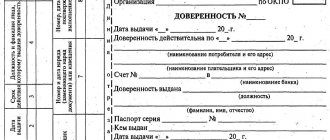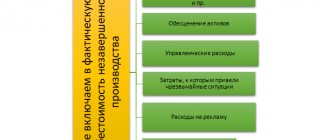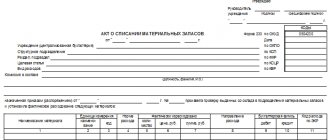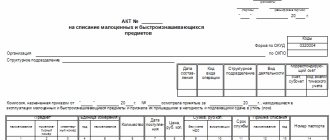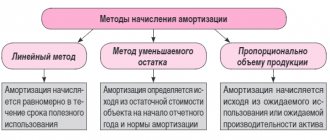PBU 05/01 “Accounting for inventories”: basic provisions
One of the main Russian regulations for regulating the accounting of inventories is PBU 05/01 (approved by order of the Ministry of Finance of Russia dated 06/09/2001 No. 44n). It, in particular, provides a definition of MPZ (clause 2 of PBU 05/01). They represent assets:
- involved in the production of goods, performance of work or provision of services as raw materials or supplies;
- intended for sale (finished products, goods purchased from a supplier);
- used to meet the needs of the enterprise.
IMPORTANT! From 2021, PBU 5/01 will no longer be in force. It will be replaced by FSBU 5/2019 “Reserves”. The norms of this FSBU differ significantly from the provisions of PBU 5/01. The new standard must be applied starting with reporting for 2021. You can start applying the standards earlier.
ConsultantPlus experts explained in detail how to switch to inventory accounting in accordance with FAS 5/2019. Get trial access to K+ and upgrade to the Ready Solution for free.
Inventory accounting units can be:
- stock item number;
- the consignment;
- group of homogeneous materials;
- another unit of accounting determined by the organization and allowing to ensure the reflection of reliable information about inventories, as well as to establish control over their availability and movement.
IMPORTANT! The norms of PBU 05/01 do not apply to work in progress balances, although data on them is included in line 1210 “Inventories” of the balance sheet form.
For information on how work in progress balances are included in line 1210, read the article “Main production in the balance sheet (nuances)” .
The key issues discussed in PBU 05/01 are the assessment of inventories when accepting them for accounting and disposal, as well as the rules for reflecting data about them in accounting records.
Who submits “simplified” reporting
As a general rule, small businesses have the right to prepare reports using both regular and simplified forms (Part 4, Article 6 of Law No. 402-FZ). The difference between simplified forms and regular ones is that they reflect all indicators by groups of articles.
The only business entities that cannot submit “simplified” reporting are:
- organizations whose accounting (financial) statements are subject to mandatory audit in accordance with the legislation of the Russian Federation;
- lawyer consulting;
- microfinance organizations. These include legal entities included in the state register of microfinance organizations and engaged in providing microloans, the amount of which cannot exceed 1 million rubles (clauses 1, 2, 3, part 1, article 2 of the Federal Law of July 2, 2010 No. 151- Federal Law “On microfinance activities and microfinance organizations”).
For organizations that have the right to use simplified methods of accounting, including simplified financial statements, simplified forms of the Balance Sheet and Statement of Financial Results have been approved (clause 6.1 of Order No. 66n of the Ministry of Finance of Russia dated July 2, 2010).
Accounting for the capitalization of inventories according to PBU 05/01
The procedure under consideration involves the acceptance of inventories for accounting at their actual cost, consisting of the costs of purchasing or manufacturing materials minus VAT and other taxes, which are returned by the state (unless otherwise provided by law).
Here are examples of costs that form the actual cost of inventories purchased from a third party:
- payment under the supply agreement;
- expenses for consulting services provided during the acquisition of inventories;
- customs duties;
- taxes that are not refundable from the budget;
- intermediary remuneration;
- fare;
- expenses for insurance of inventories, etc.
In general, eligible costs can include any costs that are associated with the purchase of inventory from a supplier.
The actual cost of inventories produced independently is determined based on the actual costs associated with the release of the corresponding stocks. Accounting and formation of these costs is carried out in the manner established by the accounting policy for calculating the cost of manufactured products.
If a company conducts accounting according to a simplified scheme, it can:
- Evaluate purchased inventories at the supplier's price, including associated costs as expenses immediately as they are implemented (clause 13.1 of PBU 5/01).
- Being a micro-enterprise, immediately upon acquisition, include in expenses the cost of inventories used in the normal activities of this enterprise (clause 13.2 of PBU 5/01). This method is also available to other organizations with simplified accounting, but only in a situation where their activities do not generate significant inventory balances.
- Immediately write off as expenses all expenses for the purchase of inventories for management needs, including their cost determined by the supplier (clause 13.3 of PBU 5/01).
If the materials and materials do not belong to the company, but it disposes of them in accordance with the terms of the contract, the materials are taken into account in the assessment provided for in this contract.
Who is a small business?
The categories of small and medium-sized businesses are established by Federal Law No. 209-FZ of July 24, 2007 “On the development of small and medium-sized businesses in the Russian Federation” (hereinafter referred to as Law No. 209-FZ). These include business societies, business partnerships, production cooperatives, agricultural consumer cooperatives, peasant (farm) households and individual entrepreneurs, if they meet the criteria specified in Part 1.1 of Law No. 209-FZ. For example, business companies (joint stock and limited liability) are recognized as small and medium-sized businesses if:
1. The requirements specified in paragraph 1 of part 1.1 of Article of Law No. 209-FZ have been met. One of them is based on the share of participation in the authorized capital of a joint-stock company or LLC of the state, public, religious and charitable organizations and other foundations, foreign legal entities or legal entities that are not small and medium-sized businesses.
2. The average number of employees of the company for the previous calendar year does not exceed one hundred people. At the same time, among small enterprises, microenterprises with a maximum number of employees of fifteen people are distinguished. The average headcount should be determined in accordance with the Instructions for filling out the federal statistical observation form No. PM “Information on the main performance indicators of a small enterprise”, approved by Rosstat order No. 33 dated January 29, 2016.
3. The “tax” income of the company from business activities for the previous calendar year in the amount of all types of activities carried out and all tax regimes does not exceed 800 million rubles for a small enterprise, and 120 million rubles for a micro-enterprise (clause 1 of the resolution of the Government of the Russian Federation dated 07/13/2015 No. 702).
Valuation of reserves upon disposal according to PBU 05/01
Another inventory accounting procedure regulated by PBU 05/01 is their assessment upon disposal. It can be carried out based on:
- from the cost of a unit of material stock;
- average cost of inventories;
- the cost of the very first purchased inventories - using the FIFO method.
If inventories are used by a company in a special manner or are not interchangeable in normal use, they can be valued based on the cost of each unit of inventory.
If the accounting policy defines a specific method of accounting for inventories for the reporting year, only this method should be used during the corresponding period. The method of accounting for inventories is selected based on its applicability to the activities carried out by the legal entity.
The assessment of inventories that do not relate to goods, which are recorded at sales value, as of the end of the reporting period is carried out in the same way as is used when disposing of the corresponding inventories.
Write-off of materials step-by-step instructions for accounting
Any organization acquires materials for the company’s activities not for their own sake. And the purchased valuables will not lie dead weight in the warehouse for the director to admire. They are intended for use in production, sales or administrative purposes. Therefore, purchased materials are subsequently consumed in production.
However, in the warehouse the storekeeper or warehouse manager is responsible for them, and the materials are taken into account on account 10. When the materials leave the warehouse, the situation will change: the account and the person in charge will change. In this article we will analyze the write-off of materials with step-by-step instructions for this procedure for you.
The content of the article:
1. Accounting entries for writing off materials
2. Registration of write-off of materials
3. Write-off of materials - step-by-step instructions if not everything is consumed
4. Standards for writing off materials for production
5. Example of a write-off act
6. Methods for writing off materials for production
7. Option No. 1 – average cost
8. Option No. 2 – FIFO method
9. Option No. 3 – at the cost of each unit
So, let's go in order. If you don't have time to read a long article, watch the short video below, from which you will learn all the most important things about the topic of the article.
(if the video is not clear, there is a gear at the bottom of the video, click it and select 720p Quality)
We will look at write-offs of materials in more detail than in the video later in the article.
Accounting entries for write-off of materials
So, let's start by determining where the purchased materials can be sent. It should be noted that materials are truly ubiquitous and there are ways to, as they say, “plug a hole” in any problem area of the organization:
- - serve as the basis for the production of products
- - be an auxiliary consumable material in the production process
- — perform the function of packaging finished products
- - used for the needs of the administration in the management process
- — assist in the liquidation of decommissioned fixed assets
- - used for the construction of new fixed assets, etc.
And the accounting entries for writing off materials depend on what materials are released from the warehouse for:
Debit 20 “Main production” – Credit 10 – raw materials released for production
Debit 23 “Auxiliary production” - Credit 10 - materials were released to the repair shop
Debit 25 “General production expenses” – Credit 10 – rags and gloves were issued to the cleaner servicing the workshop
Debit 26 “General business expenses” – Credit 10 – paper for office equipment issued to the accountant
Debit 44 “Sales expenses” – Credit 10 – containers for packaging finished products were issued
Debit 91-2 “Other expenses” – Credit 10 – materials released for liquidation of fixed assets
It is also possible for a situation where it is discovered that the materials listed in the accounts are actually missing. Those. there is a shortage. For such a case, there is also an accounting entry:
Debit 94 “Shortages and losses from damage to valuables” – Credit 10 – missing materials written off
Registration of write-off of materials
Any business transaction is accompanied by the preparation of a primary accounting document, and write-off of materials is no exception. The step-by-step instructions in the next paragraph contain the study of the primary documents that accompany the write-off process.
Currently, any commercial organization has the right to independently determine the set of documents that will be used to formalize the write-off of materials, so the registration of write-off of materials may vary from organization to organization.
The main thing is that the documents used are approved as part of the accounting policy and contain all the mandatory details provided for in Article 9 of Law No. 402-FZ “On Accounting”.
Standard forms that can be used when writing off materials (approved by Resolution of the State Statistics Committee of October 30, 1997 No. 71a):
- — requirement-invoice (form No. M-11) is applied if the organization has no limits on receiving materials
- — limit-fence card (form No. M-8) is used if the organization has established limits on the write-off of materials
- — an invoice for the release of materials to the third party (form No. M-15) is applied to another separate division of the organization.
The organization can modify these forms - remove unnecessary details and add details that the organization needs.
The invoice requirement is suitable for accounting for the movement of material assets within an organization, between financially responsible persons or structural divisions.
The invoice in two copies is drawn up by the financially responsible person of the structural unit handing over material assets. One copy serves as the basis for the handing over unit to write off valuables, and the second copy serves as the basis for the receiving unit for the receipt of valuables.
Write-off of materials step-by-step instructions if not everything is consumed
Usually, when preparing these documents, it is assumed that the released materials were immediately used for their intended purpose, which means they are accompanied by the postings that we discussed above - for credit 10 of the account and debit 20, 25, 26, etc.
But this does not always happen, especially in large production. Materials transferred to the work site or workshop may not be immediately used in production. In fact, they simply “move” from one storage location to another. In addition, when dispensing materials, it is not always known what type of product they are intended for.
Therefore, those materials that are released from the warehouse but not consumed should not be taken into account as expenses of the current month, neither in accounting nor in tax accounting for income tax. What to do in this case, how to write off materials, step by step instructions below.
In such situations, the release of materials from the warehouse to the production department should be reflected as an internal movement, using a separate subaccount to account 10, for example, “Materials in the workshop.” And at the end of the month, another document is drawn up - a materials consumption act, where the direction of materials consumption will already be visible. And at this moment the materials will be written off.
Such tracking of material consumption will allow you to achieve greater reliability in accounting and correctly calculate income tax.
Please note that this applies not only to materials that go into production, but also to any property, including stationery used for administrative needs. Materials should not be issued “in reserve”. They must be used immediately. Therefore, a one-time operation to write off 10 calculators for an accounting department of 2 people, during an audit, will certainly raise questions as to what purpose they were required in such quantities.
Example of a write-off act
That's why:
- - or you issue and immediately write off only what is actually consumed (in this case, the requirement of an invoice is quite sufficient)
- - or you draw up an act for writing off materials (transmitting a demand invoice, and then gradually writing off acts for writing off).
If you use write-off acts, do not forget to also approve their form as part of the accounting policy.
The act usually indicates the name, and, if necessary, the item number, quantity, accounting price and amount for each item, number (code) and (or) name of the order (product, product) for the manufacture of which they were used, or number (code) and (or) the name of the costs, the quantity and amount according to consumption standards, the quantity and amount of consumption in excess of the standards and their reasons.
An example of what such an act might look like is in the picture below. I repeat, this is just an example; the type of act will very much depend on the specifics of the enterprise. Here, as a basis, I took the form of the act that is used in budgetary institutions.
Standards for writing off materials for production
Accounting legislation does not establish standards in accordance with which materials should be written off for production. But paragraph 92 of the Methodological Guidelines for the accounting of MPZ (Order of the Ministry of Finance dated December 28, 2001 No. 119n) states that materials are released into production in accordance with established standards and the volume of the production program. Those. the amount of materials written off should not be uncontrolled and the standards for writing off materials into production should be approved.
In addition, for tax accounting it would be useful to remember Article 252 of the Tax Code: expenses are economically justified and documented.
The organization sets its own standards for materials consumption (limits) . They can be fixed in estimates, technological maps and other similar internal documents. Documents of this kind are not developed by the accounting department, but by the unit that controls the technological process (technologists), and then they are approved by the manager.
Materials are written off for production in accordance with approved standards. You can write off materials in excess of the norm, but in each such case you need to explain the reason for the excess write-off. For example, correction of defects or technological losses.
The release of materials in excess of the limit is carried out only with the permission of the manager or his authorized persons. On the primary accounting document - the demand invoice, the act - there must be a note about the excess write-off and its reasons. Otherwise, the write-off is illegal and leads to a distortion of the cost and accounting and tax reporting.
On the topic of expenses in the form of technological losses, you can read: Resolution of the Federal Antimonopoly Service of the North Caucasus District dated 02/04/2011. No. A63-3976/2010, letters from the Ministry of Finance of Russia dated July 5, 2013. No. 03-03-05/26008, dated January 31, 2011. No. 03-03-06/1/39, dated 10/01/2009 No. 03-03-06/1/634.
Methods for writing off materials for production
So, now we know what documents we need to write off materials, and we also know the accounts to which they are debited. From the documents we know how much materials were written off. Now all that’s left to do is determine the cost of their write-off. How can we determine how much the materials sold cost, and what amount will be the write-off entry? Let's look at a simple example, based on which we will study the methods of writing off materials for production.
Example
Sladkoezhka LLC produces chocolate candies. Cardboard boxes are purchased for their packaging. Let 100 such boxes be purchased at a price of 10 rubles. a piece. A packer comes to the warehouse to pick up boxes and asks the storekeeper to give him 70 boxes.
So far we have no question about how much each box costs. The packer receives 60 boxes for 10 rubles, for a total of 600 rubles.
Even if 80 boxes were purchased, but the price is already 12 rubles. a piece. The same boxes. Of course, the storekeeper doesn't keep the old and new boxes separate, they are all kept together. The packer came again and wants more boxes - 70 pieces. The question is: at what price will the boxes sold for the second time be valued? It is not written on each box exactly how much it cost - 10 or 12 rubles.
Different answers can be given to this question, depending on which method of writing off materials for production is approved in the accounting policy of Sladkoezhka LLC.
Option No. 1 – average cost
After the packer left the warehouse with the boxes for the first time, there were 40 boxes left for 10 rubles each. – this will be, as they say, the first game. Another 80 boxes were purchased for 12 rubles. - This is already the second batch.
Let's count the results: we now have 120 boxes for a total amount of: 40 * 10 + 80 * 12 = 1360 rubles. Let’s calculate how much a box costs on average:
1360 rub. / 120 boxes = 11.33 rub.
Therefore, when the packer comes for the second time for boxes, we will give him 70 boxes for 11.33 rubles, i.e.
70*11.33=793.10 rub.
And we will have 50 boxes left in the warehouse worth 566.90 rubles.
This method is called average cost (we found the average cost of one box). As new batches of boxes continue to arrive, we will again calculate the average and issue boxes again, but at a new average price.
Option No. 2 - FIFO method
So, by the time of the packer’s second visit, we have 2 batches in our warehouse:
No. 1 - 40 boxes for 10 rubles. – according to the time of acquisition, this is the first batch – the “older” one
No. 2 – 80 boxes for 12 rubles. - according to the time of acquisition, this is the second batch - more “new”
We assume that we will issue the packager:
40 boxes from the “old” one - the first batch purchased at the price of 10 rubles. – total for 40*10=400 rub.
30 boxes from the “new” one - the second batch in time to purchase at a price of 12 rubles. – total for 30*12=360 rub.
In total, we will issue in the amount of 400 + 360 = 760 rubles.
There will be 50 boxes left in the warehouse at 12 rubles, for a total of 600 rubles.
This method is called FIFO - first in, first out. Those. First, we sort of release material from an older batch, and then from a new one.
Option No. 3 – at the cost of each unit
At the cost of a unit of inventory, i.e. Each unit of materials has its own cost. This method is not applicable for ordinary cardboard boxes. Cardboard boxes are no different from each other.
But materials and goods used by the organization in a special manner (jewelry, precious stones, etc.), or inventories that cannot normally replace each other, can be valued at the cost of each unit of such inventories. Those. If all our boxes were different, we would put a different tag on each one, then each of them would have its own cost.
Here are the most important questions on the topic of writing off materials: step-by-step instructions are now before your eyes. For those who keep records in the 1C: Accounting program, watch a video tutorial on writing off materials in this program.
What problematic issues do you have regarding the write-off of materials? Ask them in the comments!
You can also, which were mentioned in the article, on the issue of technological losses.
About accounting for receipt of materials, see here.
Write-off of materials step-by-step instructions for accounting
Reflection of inventories in financial statements according to PBU 05/01
PBU 05/01 also regulates the procedure for reflecting information about inventories in accounting reports. Inventories should be reflected in it in accordance with a classification that takes into account the method of their use in economic activities.
As of the end of the reporting year, inventories are shown on the balance sheet at cost, which is established based on the methods used to evaluate the corresponding reserves.
Materials and equipment that are obsolete or have lost their marketable appearance or have become cheaper are reflected in the balance sheet at the end of the year minus the reserves provided for the reduction in the value of inventories. The corresponding reserve is formed at the expense of financial results by the amount of the difference between the market value and the actual cost of inventories if the second indicator is higher than the first. This norm may not be followed by companies that conduct simplified accounting (clause 26 of PBU 5/01).
Inventory that is in transit or transferred to the consumer as collateral, the rights to which have been transferred to the legal entity, are reflected in accounting based on the assessment provided for in the contract, with further clarification of their actual cost.
The following must be included in inventory accounting:
- methods for assessing MPZ in relation to their groups or varieties;
- information about the consequences of changes to these assessment methods;
- the cost of inventories pledged as collateral;
- the amount and movement of reserves for reducing the cost of materiel.
For information on how management accounting for inventories is organized, read the article “Management accounting of inventories (nuances).”
Who conducts “simplified” accounting
The list of persons who can apply simplified methods of accounting and prepare simplified accounting (financial) statements is given in Article 6 of the Federal Law of December 6, 2011 No. 402-FZ “On Accounting” (hereinafter referred to as Law No. 402-FZ). These include economic entities whose reporting is not subject to mandatory audit:
- small businesses;
- non-profit organizations;
- organizations that have received the status of participants in a project to carry out research, development and commercialization of their results in accordance with the Federal Law of September 28, 2010 No. 244-FZ “On Innovation.
Does not have the right to conduct “simplified” accounting (Part 5, Article 6 of Law No. 402-FZ):
- housing and housing construction cooperatives;
- credit consumer cooperatives (including agricultural credit consumer cooperatives);
- microfinance organizations;
- bar associations;
- law offices;
- lawyer consulting;
- bar associations;
- notary chambers;
- non-profit organizations included in the register of non-profit organizations performing the functions of a foreign agent (Clause 10, Article 13.1 of the Federal Law of January 12, 1996 No. 7-FZ “On Non-Profit Organizations”).
Has the new PBU 5/2012 “Inventory Accounting” been adopted?
Procedures related to accounting for inventories may be regulated not only by Russian, but also by international reporting standards. First of all, it is worth noting that the legislator made an attempt to adapt IFRS standards to financial and economic legal relations in Russia by developing the draft PBU 5/2012, which was supposed to establish new inventory accounting standards - instead of those defined in PBU 05/01 - taking into account international standards.
However, this project was never adopted. Nevertheless, in 2015, the Russian Ministry of Finance introduced one of the IFRSs into the Russian Federation, regulating the handling of inventories.
The new FSBU 5/2019 brings the standards of IFRS and RAS closer together.
A ready-made solution from ConsultantPlus will help you rebuild the materials accounting algorithm when applying FSBU 5/2019. Get trial access to K+ for free and proceed to the material.
Read about what Russian and international standards have in common and what distinguishes them in the article “RAS and IFRS - main similarities and differences.”
How to draw up an order to write off inventories - form and sample
The write-off procedure consists of several stages, among which a significant place is occupied by the manager’s order to appoint a commission tasked with carrying out the necessary activities.
If necessary, the document can contain the commission’s work regulations. However, usually the operating procedure of such a formation is established at the beginning of the company’s work, so as not to schedule it every time.
When choosing exactly this option, the next order remains to reflect: the name of the company, the serial number and date of the order, the purpose of forming the commission, its personal composition and, finally, the signature of the director.
You can view a sample order for write-off of inventories on our website.
Inventory accounting according to IFRS: governing legislation
We are talking about the adoption of International Standard (IAS) 2 “Inventories”. It was put into effect by order of the Ministry of Finance of the Russian Federation dated December 28, 2015 No. 217n; its text in Russian is given in Appendix 2 to this order.
In this legal regulation, reserves are understood as assets that:
- held for sale in the ordinary course of business of the firm;
- are manufactured in production for the purpose of further sale;
- are in the form of raw materials or materials that are used by the company in production or in the provision of services.
Inventories in IFRS also mean:
- goods purchased by the company for the purpose of further resale;
- finished products;
- remains of work in progress, which are subject to further use by the company during production.
By analogy with the procedures discussed above, regulated by Russian PBU 05/01, we will consider which standards of IFRS 2 can be applied to assess the value of inventories and generate reports on inventories.
Act on write-off of inventories - sample form F-0504230 (OKUD)
Organizations must write off inventories using a write-off act. For this document, a special form 0504230 of the act on write-off of inventories is provided, approved by order of the Ministry of Finance of the Russian Federation dated March 30, 2015 No. 52n, which allows you to register write-offs using all existing methods.
In the header of the act, its number in order, the date of preparation, the composition of the commission that carried out the write-off procedure and the order by which this composition was approved are indicated.
In the tabular form that follows, data on the consumption of inventories is recorded: names, codes, consumption rates, actual consumption, reasons that led to the write-off, Dt and Kt for accounting entries. At the bottom of the table the total results are summed up, followed by the conclusion of the commission and the signatures of all its members indicated in the header of the act.
You can download the form for the act on write-off of inventories OKUD 0504230 on our website:
You can also download a completed sample act on write-off of inventories.
Valuation of reserves according to IFRS
In accordance with IFRS 2, inventories should be measured at the lower of the following:
- cost;
- net potential selling price.
As for the cost, it should include the following costs:
- for the purchase of inventories;
- their processing;
- other costs incurred by the company in order to ensure the current location and condition of inventories.
In turn, the costs of acquiring assets include:
- purchase price of the stock;
- duties;
- non-refundable taxes;
- fare;
- costs associated with loading and unloading;
- other costs that are directly related to the purchase of inventories.
In this case, discounts and other reasons for reducing costs must be deducted from the cost of purchasing inventories.
Regarding processing costs, they should include:
- salaries of employees engaged in production;
- various overhead costs when processing raw materials.
Other costs that are taken into account when determining the cost of inventories may include, in particular, the costs of developing certain products for certain customers. Sometimes the cost structure of inventories may include borrowing costs - this procedure is regulated by separate IFRS standards.
Net potential selling price in IFRS is the estimated selling price of an asset in the ordinary course of business less estimated costs of completion and sales.
When inventories are sold, their carrying amount is recognized as an expense in the period in which the firm receives revenue from the related sales. The amount for any write-down of inventories to their net potential selling price, as well as any loss of inventory, must be recognized as an expense within the period in which the write-off or loss was recognized. Amounts for any reversals (of previously written-off inventories) due to an increase in net potential selling price should be recognized as a reduction in the amount of inventories recognized as expenses within the period in which the reversals were made.
Separate standards for determining the cost of inventories are established in IFRS 2 for companies providing services, as well as for farming organizations (paragraphs 19, 20).
When calculating the cost of goods according to IFRS, the following accounting methods can be used:
- on regulatory costs;
- retail prices.
The first method involves looking at typical levels of inventory consumption, labor, efficiency, and productivity - but these can be revised based on market conditions.
The second method is more suitable for retail, an area characterized by frequent changes in the structure of inventories, as well as revenue indicators for their sales or products manufactured using materials.
Simplified accounting forms
The official website of the Ministry of Finance (minfin.ru) contains the document “Recommendations for small businesses on the use of simplified methods of accounting and preparation of accounting (financial) statements” (hereinafter referred to as the Recommendations). The recommendations were developed by the Institute of Professional Accountants and Auditors of Russia.
Three possible ways to organize simplified accounting are recommended:
- Full form. It resembles ordinary accounting, since here, too, all business transactions are accounted for using the double entry method in the appropriate registers;
- Short form. It provides that all facts of economic life must be recorded through double entry in one document - the Book (journal) of accounting for the facts of economic life. The form of this book can be developed independently on the basis of Form No. K-1 MP, approved in Appendix 11 to the Recommendations. The amounts for each transaction in the Book in the column “Amount” must be reflected in a double entry - simultaneously in the columns “Debit” and “Credit” of the corresponding accounts of the working Chart of Accounts;
- A simple system for introducing accounting. Only micro-enterprises can maintain accounting records using a simple system. In this case, there is no double entry (that is, the amounts for the debit and credit of accounts do not need to be reflected). All business transactions are recorded in a separate journal. It can be compiled on the basis of the Book (journal) of recording the facts of economic life (form No. K-2 MP), given in Appendix 12 to the Recommendations.
Inventory reporting in accordance with IFRS
IFRS requires firms to disclose when reporting inventories:
- the principles of the adopted accounting policy regarding the valuation of inventories, as well as the formula for estimating their cost;
- the total cost of all inventories for inventories, as well as specific types of inventories that are used in the organization;
- the carrying amount of inventories, which are accounted for at fair value, but less costs to sell;
- the size of inventories, which are recognized as expenses within the reporting period;
- amounts for any write-offs of the cost of inventories that are recognized as expenses within the reporting period;
- amounts for any reversals of write-offs that are recognized as a decrease in inventory, which is reflected as an expense within the reporting period;
- obligations or events as a result of which the write-off of the cost of inventories was restored;
- the book value of inventories that were pledged as a means of fulfilling the company’s obligations.
Fair value in the context of IFRS 2 is the price that a firm would receive to sell an inventory or pay to transfer a liability in an orderly transaction with a counterparty at the time the asset is measured.
Read about who in the Russian Federation has the obligation to prepare financial statements under IFRS here .
PBU 17/02 - R&D
As a general rule, R&D expenses that yield a positive result are written off as expenses for ordinary activities from the 1st day of the month following the month in which the actual application of the results obtained from R&D in the production of products (performance of work, provision of services) began ), or for the management needs of the organization (clause 10 of PBU 17/02 “Accounting for expenses for research, development and technological work”, approved by order of the Ministry of Finance of Russia dated November 19, 2002 No. 115n, hereinafter referred to as PBU 17/02). You can write off R&D expenses either linearly or in proportion to the volume of products, work, and services (clause 11 of PBU 17/02). Let's give an example.
Example 10
. Reflection of R&D expenses under “regular” accounting
The organization paid a third-party contractor for work to improve its products at a cost of 81,000 rubles. (without VAT). The work gave a positive result, which is used in production activities. In the month of completion of the work, the organization made settlements with the contractor and began using the results of R&D that are not subject to legal protection. The period for writing off R&D expenses on a straight-line basis is four and a half years (54 months).
An accountant conducting “regular” accounting will make the following entries:
DEBIT 08-8 CREDIT 60
— 81,000 rub. – the debt for payment for work performed is reflected;
DEBIT 04 CREDIT 08-8
— 81,000 rub. – R&D that produced a positive result was taken into account;
DEBIT 60 CREDIT 51
— 81,000 rub. – paid for the work performed.
From next month, monthly:
DEBIT 20 CREDIT 04
— 1500 rub. (RUB 81,000 / 54) – another part of R&D expenses was written off.
However, now an organization that has the right to conduct simplified accounting will be able to write off R&D expenses as expenses for ordinary activities in the full amount as they are carried out (clause 14 of PBU 17/02).
From when to apply innovations?
If an organization decides to take advantage of new opportunities, it will have to change its accounting policy for accounting purposes (clause 10 of PBU 1/2008 “Accounting Policy of an Organization,” approved by Order of the Ministry of Finance of Russia dated October 6, 2008 No. 106n). Such organizations can reflect changes in accounting policies in their financial statements prospectively, that is, without adjusting the reporting indicators of previous periods (clause 15.1 of PBU 1/2008).
The reporting period is the period for which the organization must prepare financial statements (clause 4 of PBU 4/99 “Accounting statements of an organization”, approved by order of the Ministry of Finance of Russia dated July 6, 1999 No. 43n, hereinafter referred to as PBU 4/99). Reporting should be prepared for the month, quarter and year on an accrual basis from the beginning of the reporting year, unless otherwise established by the legislation of the Russian Federation. The reporting period for annual financial statements (reporting year) is the calendar year - from January 1 to December 31 inclusive, with the exception of cases of creation, reorganization and liquidation of a legal entity. At the same time, the financial statements for the month and quarter are interim (Part 1, Article 15 of the Federal Law of December 6, 2011 N 402-FZ “On Accounting”, paragraph 29 of the Regulations on Accounting and Financial Reporting in the Russian Federation, approved by order Ministry of Finance of Russia dated July 29, 1998 No. 34n, clause 48 PBU 4/99).
According to the Ministry of Finance of Russia, when deciding to start using the above-mentioned simplified methods of accounting, one should proceed from the fact that in order to ensure comparability of financial statements for a number of years, changes in accounting policies are made from the beginning of the reporting year, unless otherwise determined by the reason for such a change (h 7 Article 8 of the Federal Law of December 6, 2011 No. 402-FZ “On Accounting”). In this regard, the organization has the right to decide to apply each of the above simplified accounting methods in relation to financial statements both for 2021 and for any subsequent year.

